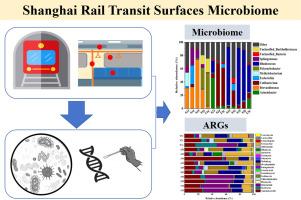Metagenomic profiling of microbial community, antibiotic resistance genes and co-occurrence pattern in megacity rail transit system
IF 2.7
引用次数: 0
Abstract
Megacity rail transit systems harbor a pivotal microbial ecosystem that serves as a reservoir for antibiotic resistance genes (ARGs), which is intricately linked to the urban dissemination of infectious diseases. Here, we conducted metagenomic sequencing to elucidate the composition of microbial communities, ARGs, and examine the co-occurrence patterns between microbes and ARGs across various surfaces in the Shanghai rail transit system. Our findings revealed that bacterial genera such as Rhodococcus, Cutibacterium, and Brevundimonas dominated, originating either from human skin or environmental sources. Notably, the bacterial diversity varied according to the type of surface and specific stations. The principal co-ordinates analysis revealed substantial beta-diversity disparities among the examined surfaces. We identified a total of 1930 ARGs conferring resistance to 20 distinct antibiotic classes, including clinically significant ones such as Aminoglycoside, Streptogramin, Multidrug, and Tetracycline, which are associated with either single or multidrug resistance. Network analysis further revealed the co-occurrence relationships between microbial genera and ARGs. This study highlights that the microbial communities and ARGs in the rail transit system are sustained by a metapopulation of human and environmental generalists. These findings provide novel insights into the mechanisms underlying the risks associated with microbial exposure and suggest strategies to mitigate the spread of pathogenic microorganisms in megacity rail transit systems, thereby enhancing public health.

特大城市轨道交通系统微生物群落、抗生素耐药基因及其共现模式的宏基因组分析
大城市轨道交通系统拥有一个关键的微生物生态系统,作为抗生素耐药基因(ARGs)的储存库,这与传染病的城市传播有着复杂的联系。在此,我们通过宏基因组测序来阐明上海轨道交通系统中微生物群落和ARGs的组成,并研究微生物和ARGs在不同表面的共现模式。我们的研究结果显示,红球菌、表皮杆菌和Brevundimonas等细菌属占主导地位,它们起源于人类皮肤或环境来源。值得注意的是,细菌多样性根据表面类型和特定站点而变化。主坐标分析显示,在被检查的表面之间存在实质性的β -多样性差异。我们共鉴定出1930种ARGs对20种不同的抗生素类具有耐药性,包括氨基糖苷、链状gramin、多药和四环素等具有临床意义的抗生素,它们与单药或多药耐药有关。网络分析进一步揭示了微生物属与ARGs的共生关系。该研究强调了轨道交通系统中的微生物群落和ARGs是由人类和环境通才组成的元种群维持的。这些发现为微生物暴露相关风险的潜在机制提供了新的见解,并提出了减轻大城市轨道交通系统中致病微生物传播的策略,从而增强了公众健康。
本文章由计算机程序翻译,如有差异,请以英文原文为准。
求助全文
约1分钟内获得全文
求助全文
来源期刊

Hygiene and environmental health advances
Environmental Science (General)
CiteScore
1.10
自引率
0.00%
发文量
0
审稿时长
38 days
 求助内容:
求助内容: 应助结果提醒方式:
应助结果提醒方式:


